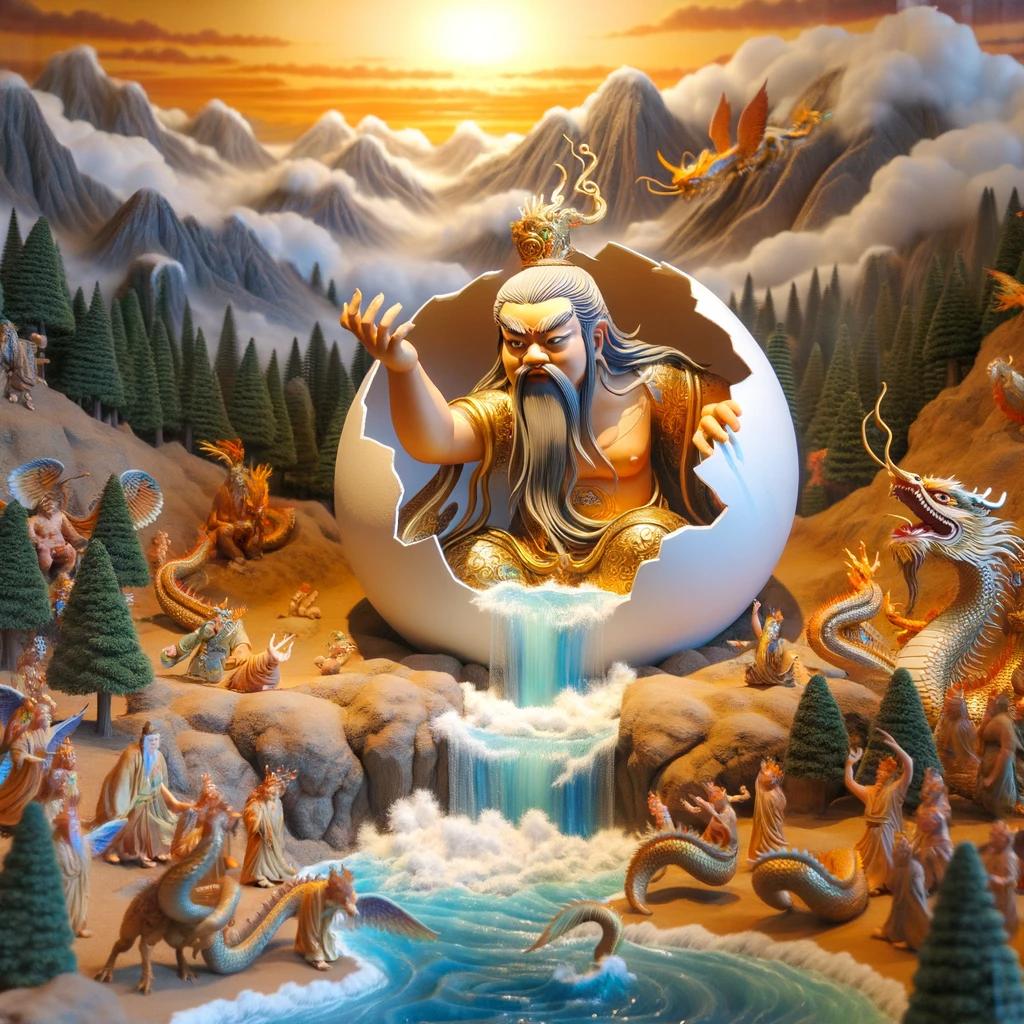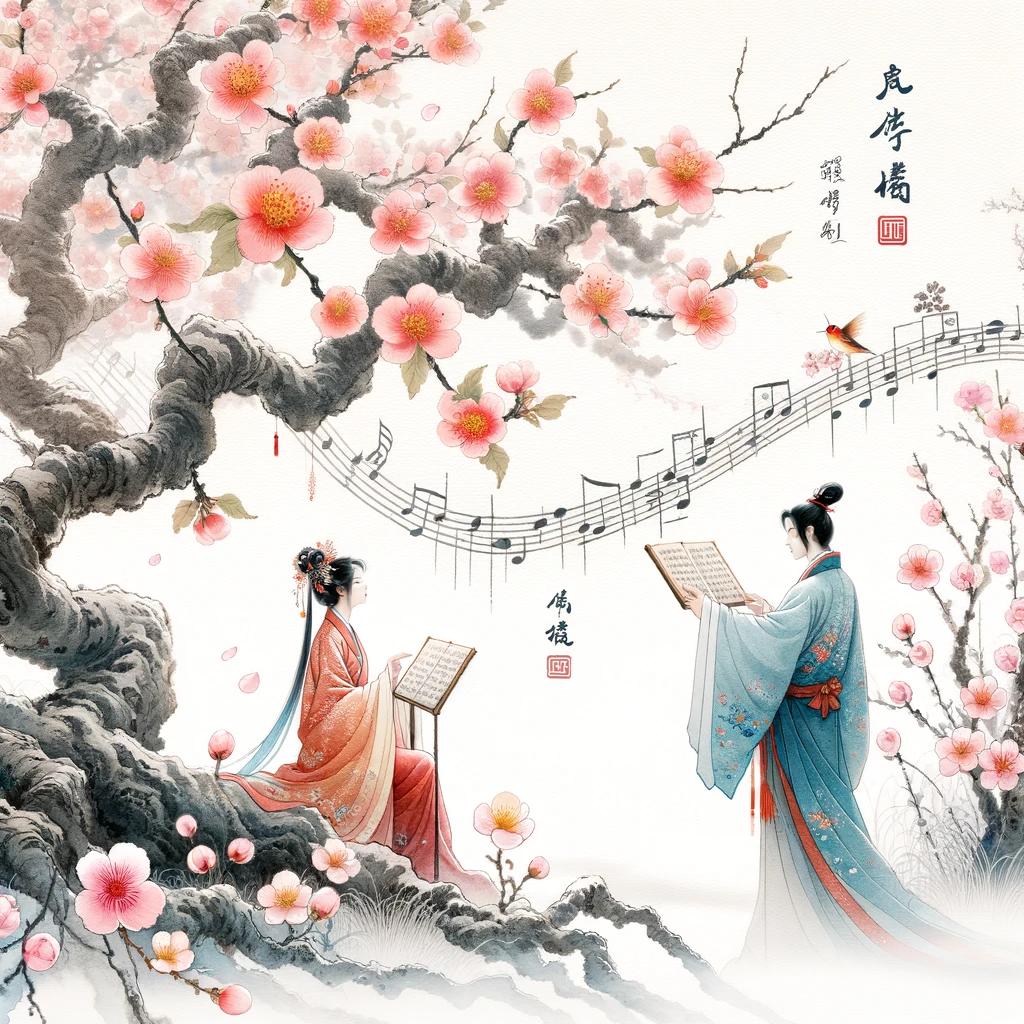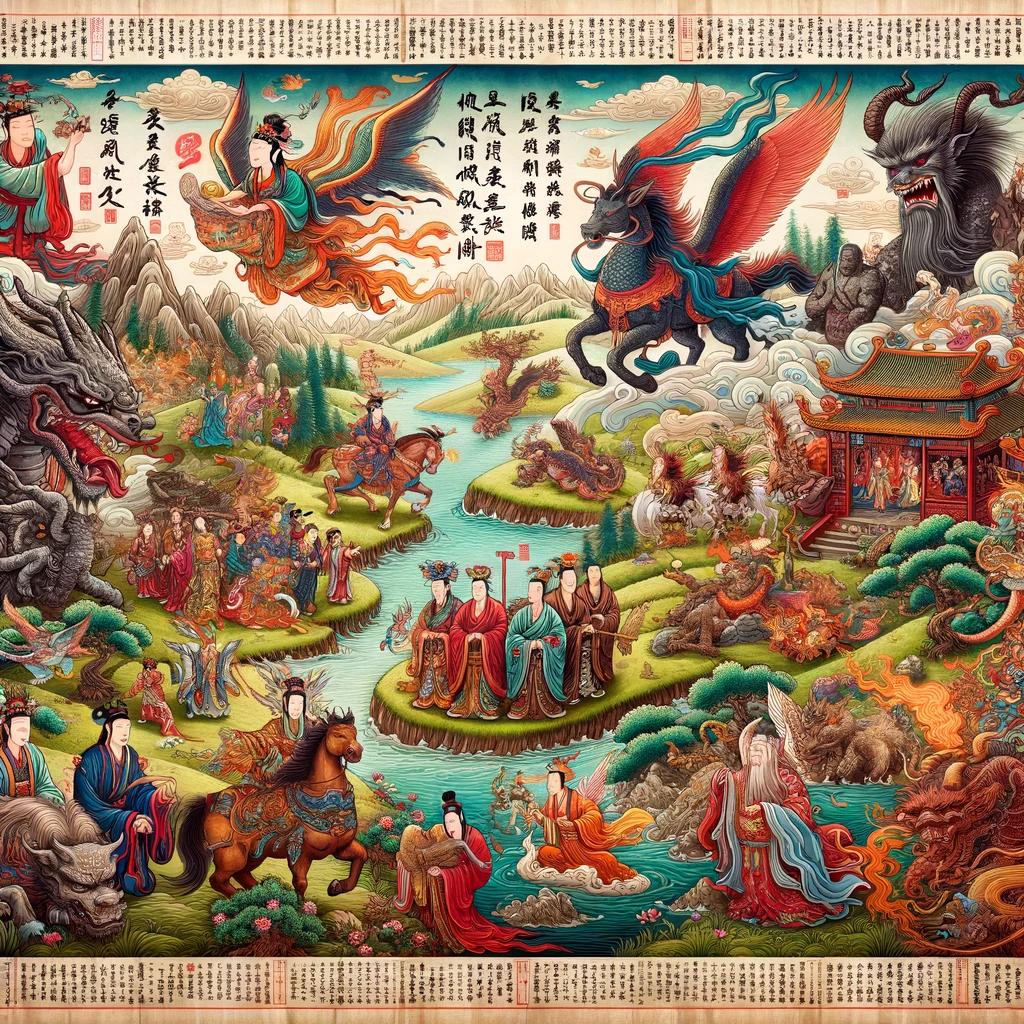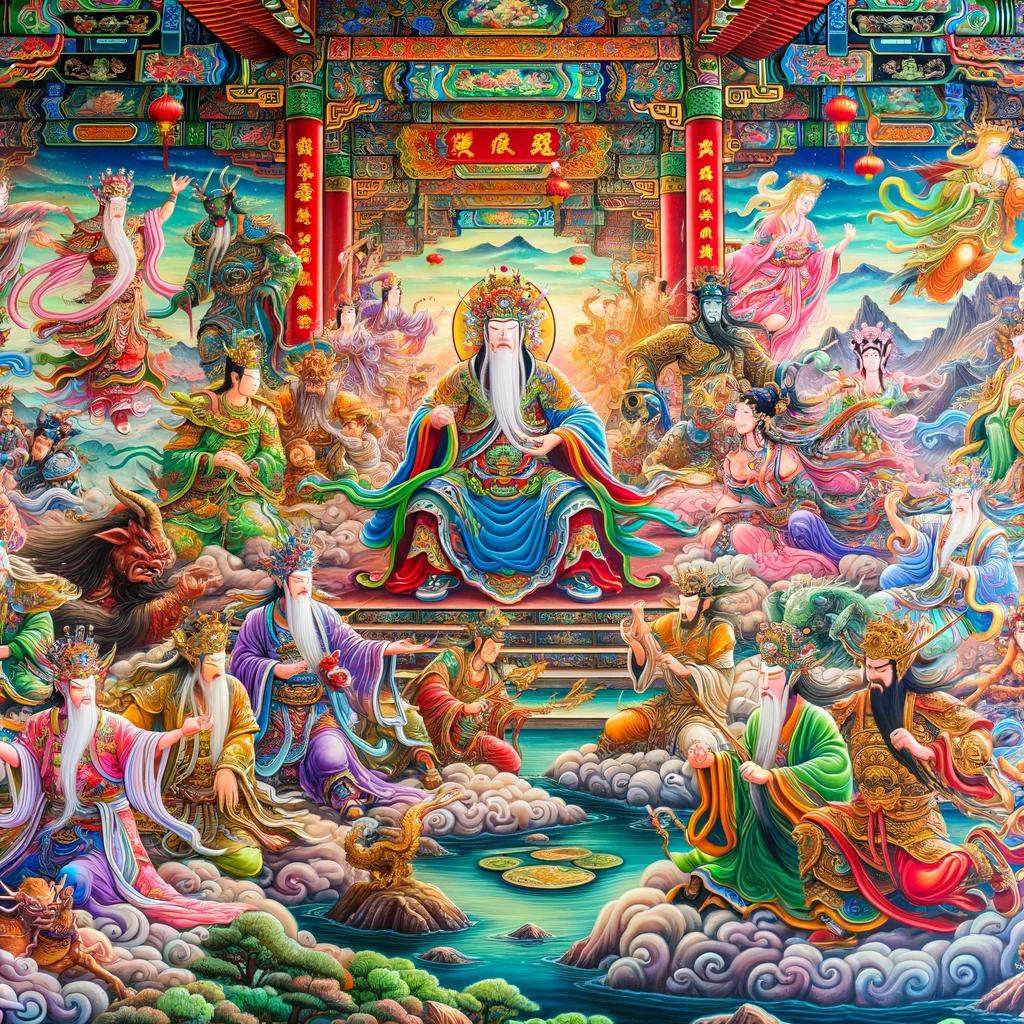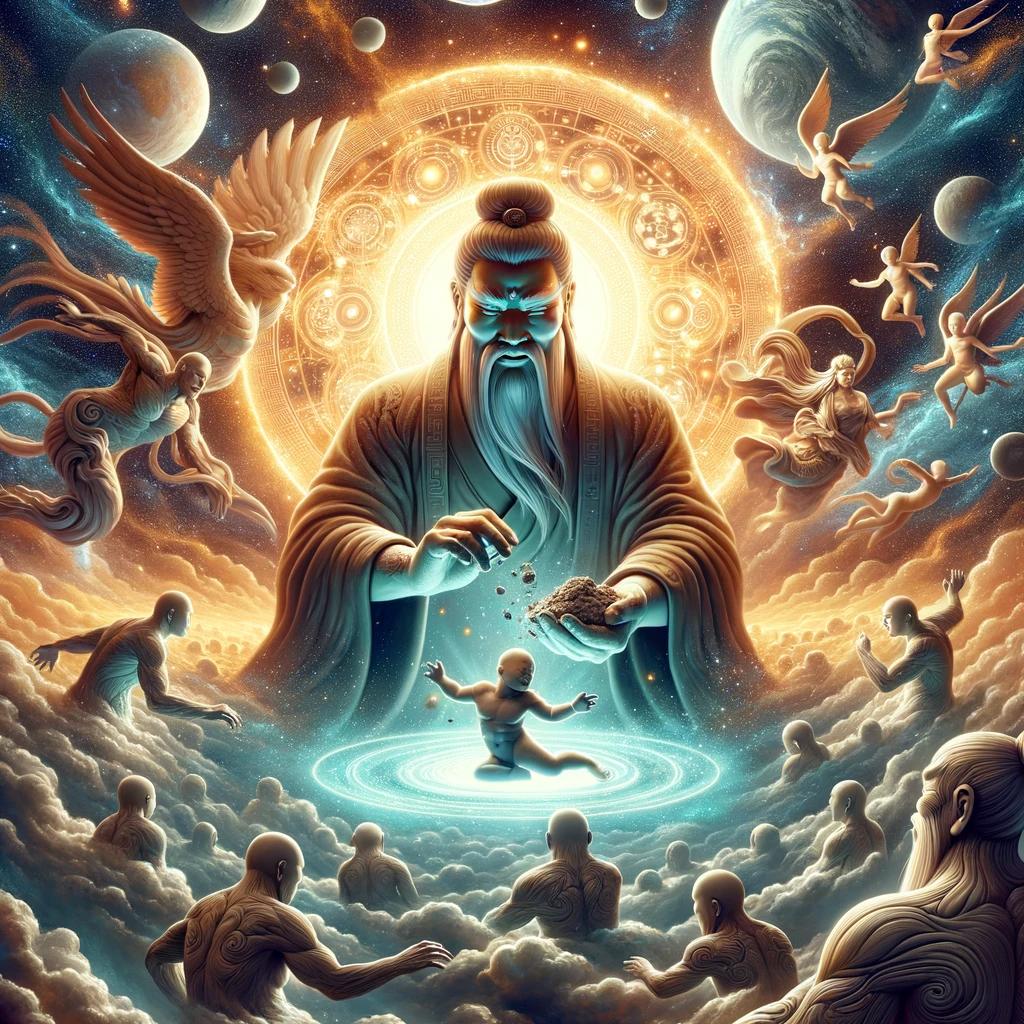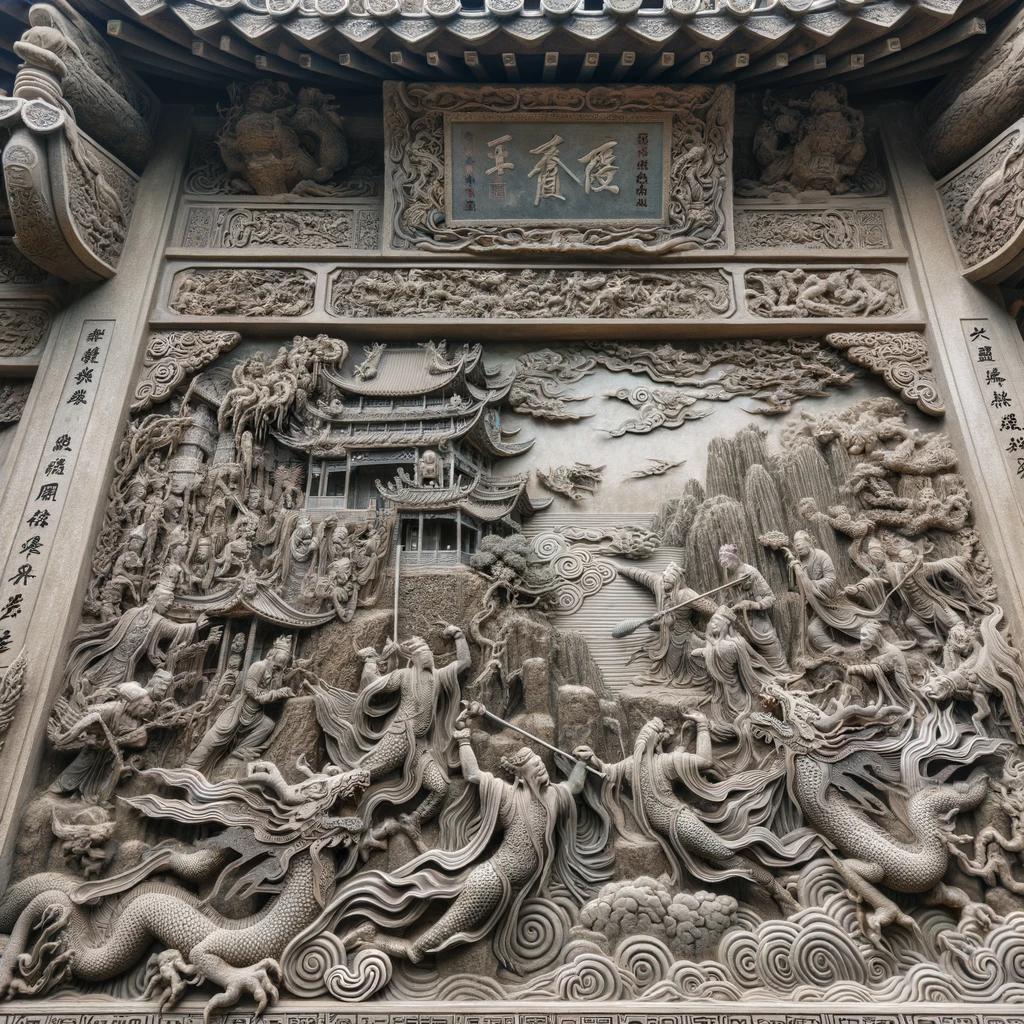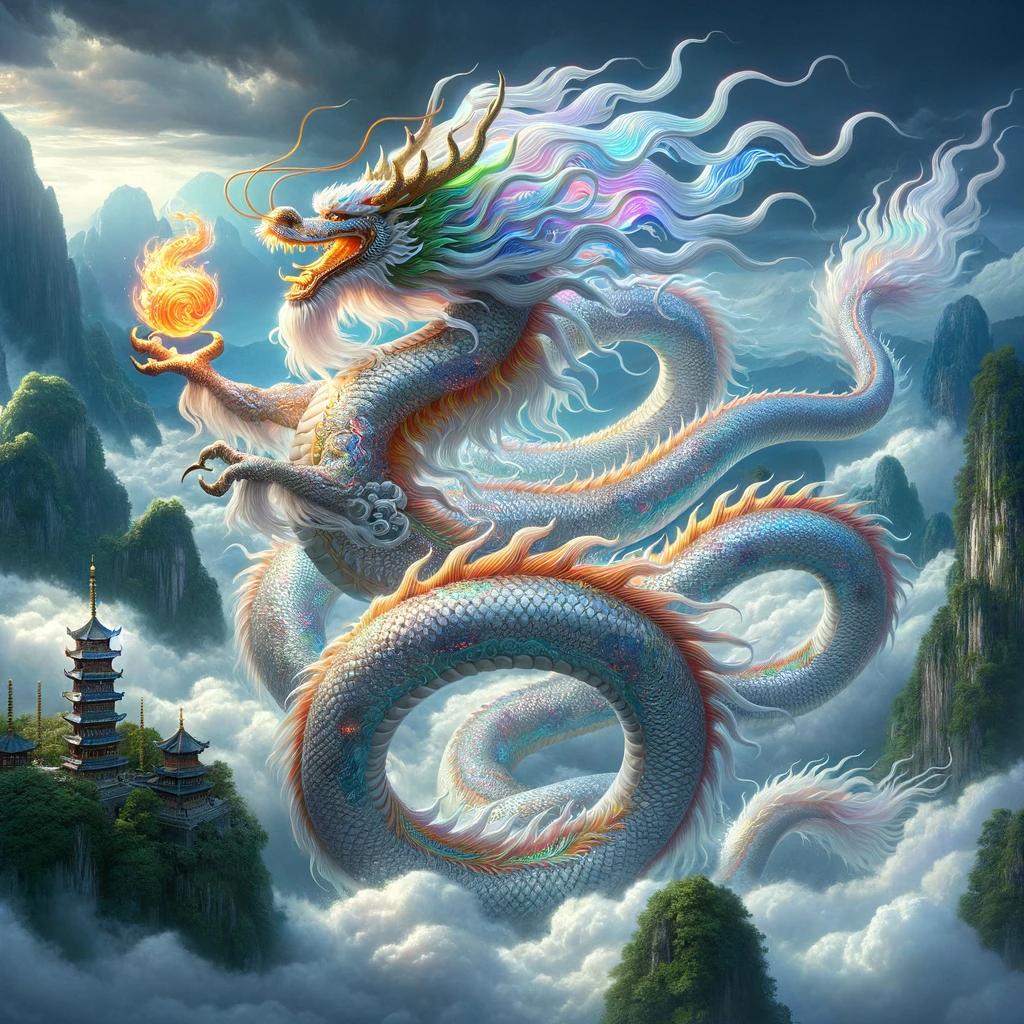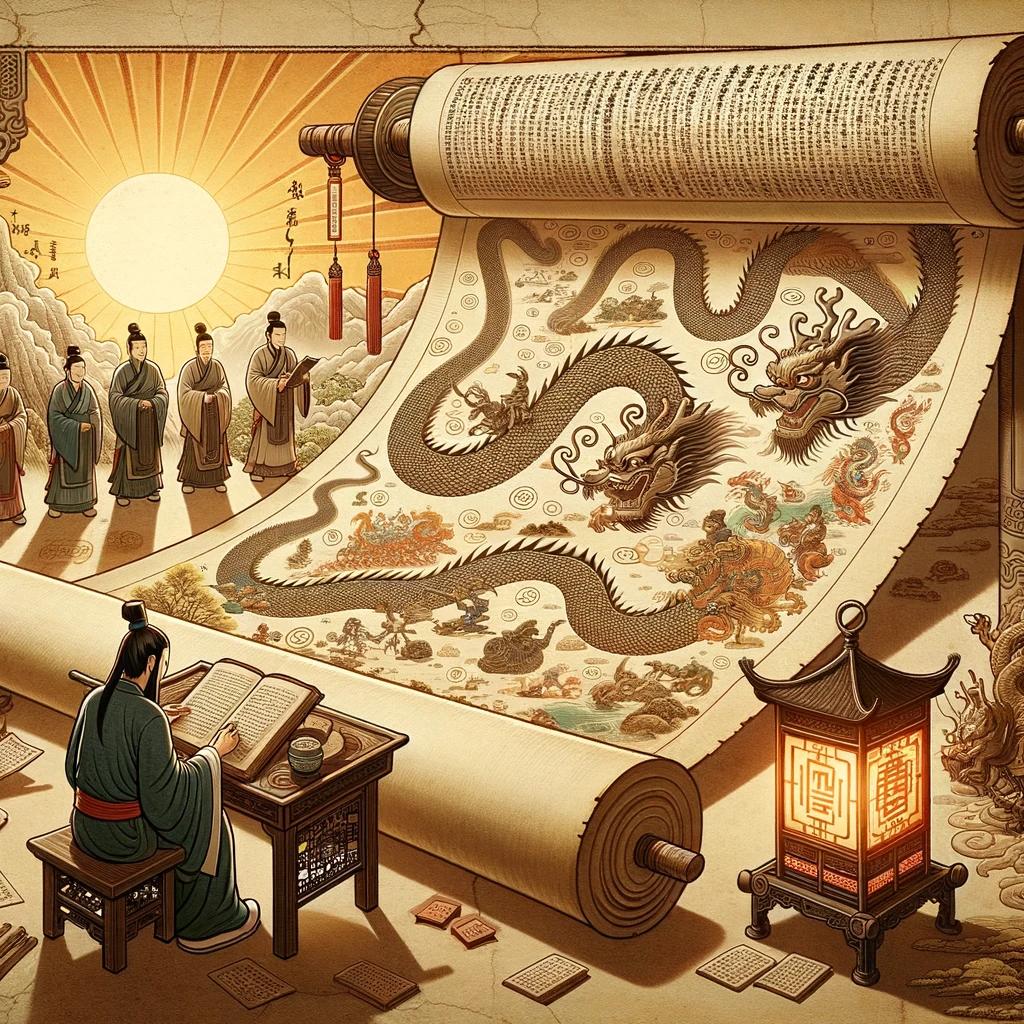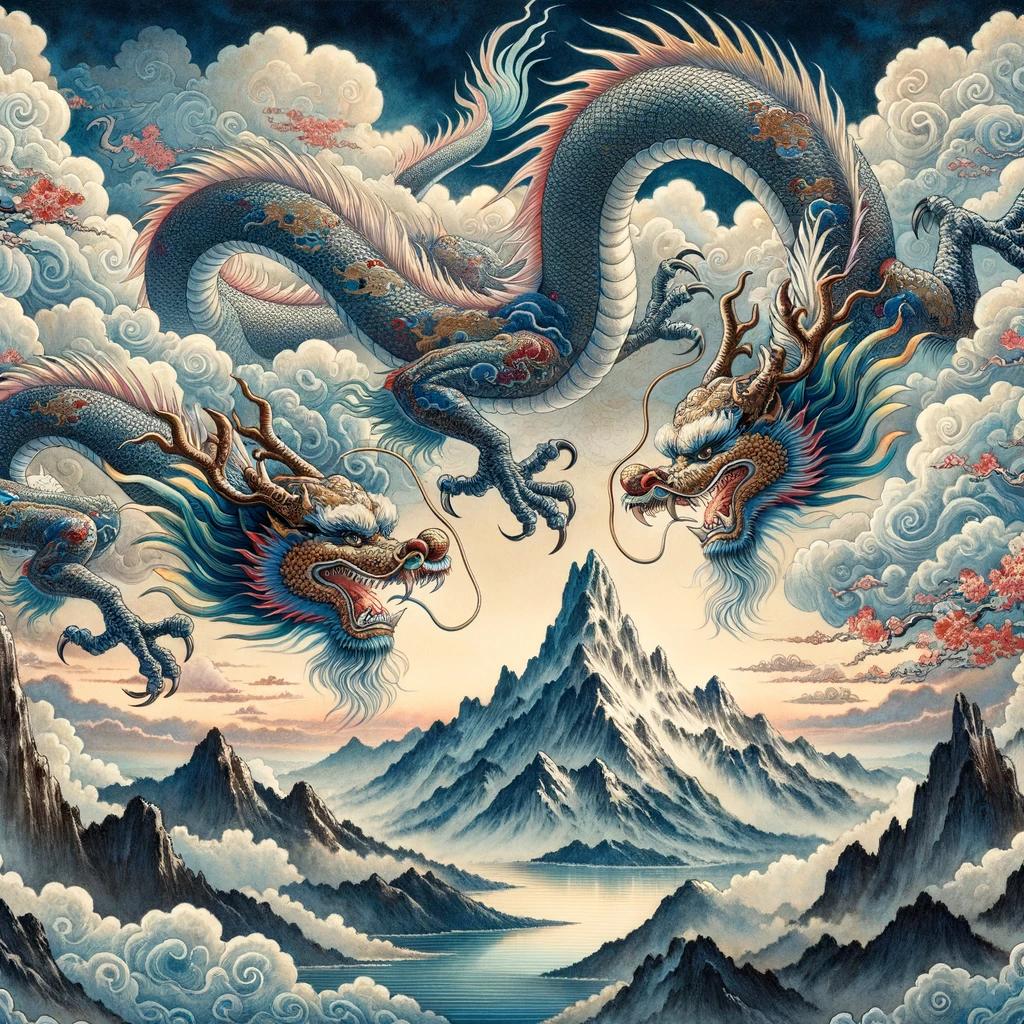Chinese Mythology Creation Story Narratives
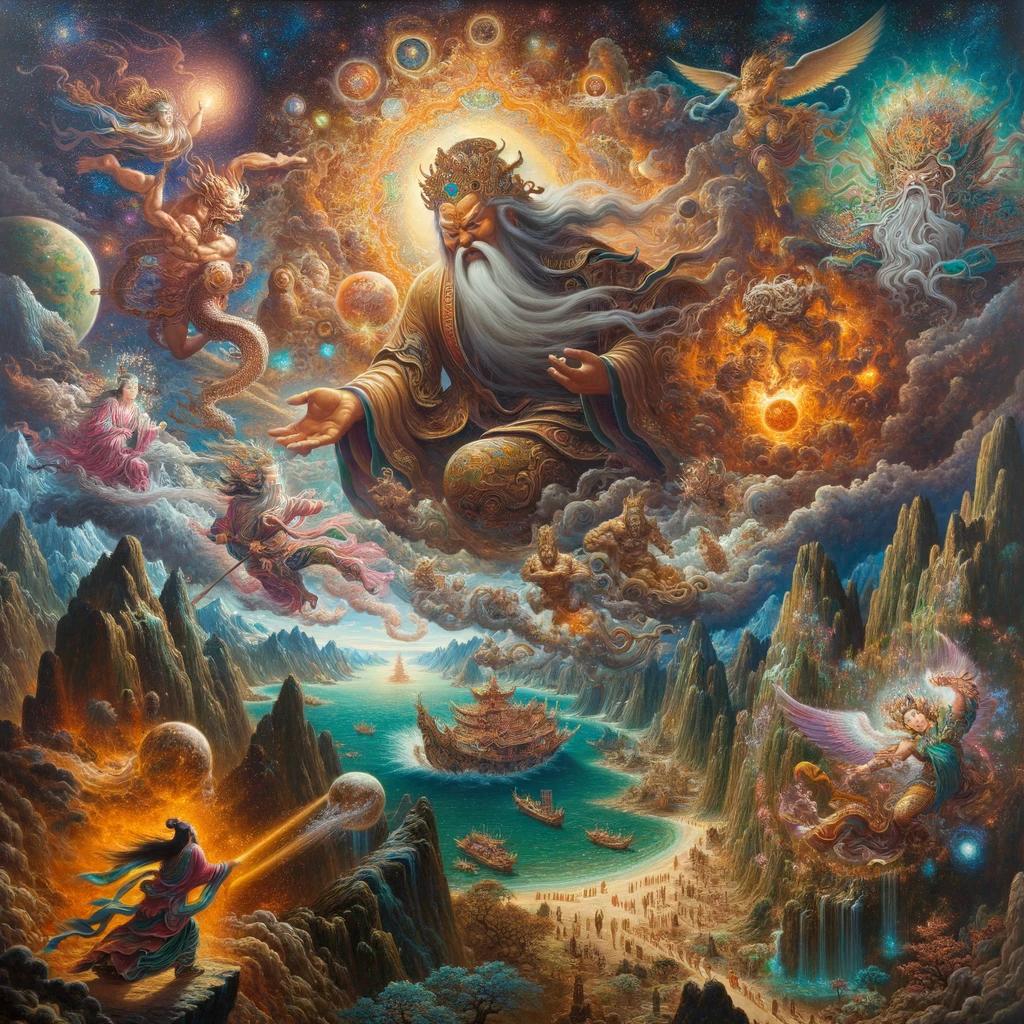
Chinese mythology Creation Story explores the ancient origins of heaven and earth. This article delves into the fascinating tale of Pangu, the cosmic giant, and the separation of yin and yang.
Discover the significance of Chinese creation myths in ancient culture, their influence on folklore, and the symbolism of mythical creatures like the Four Legendary Beasts. Explore different versions of the creation narrative, the transformation of Pangu’s body, and the concept of heaven and earth.
Unravel the captivating story of Pangu and the diverse world of Chinese mythology.
Understanding the Chinese Creation Myth
Exploring the rich tapestry of Chinese mythology takes us on a captivating journey through the origins of the universe. At the heart of this ancient belief system lies the Chinese creation myth, a fascinating tale that unravels the mysteries of how the world came into being.
Let’s delve into the depths of this myth and unravel its enigmatic components.
The Origin of the Universe: Pangu and the Egg of the World
Central to the Chinese creation myth is the figure of Pangu, a primordial being responsible for the separation of heaven and earth. According to legend, the universe was initially devoid of form or distinguishing features, existing in a primordial state.
Over the course of approximately 18,000 years, this formless state condensed into a cosmic egg.
Within this egg, the opposing principles of yin and yang achieved balance, and from this delicate equilibrium emerged Pangu. Described as a primitive, giant figure with horns on his head, Pangu embarked on the creation of the world through the act of separating yin and yang with a mighty blow from his colossal axe.
The Yin and Yang Balance: Significance in Chinese Creation
In Chinese mythology, the concept of yin and yang holds great significance. It represents the harmonious balance and interaction of opposing forces, essential in the creation of the universe. Pangu’s act of separating yin and yang signifies the birth of earth (yin turbid) and heaven (yang clear).
Pangu positions himself between the two, ensuring their separation, and pushes the sky upwards. Each day, the sky, the earth, and Pangu himself grow incrementally, symbolizing the continuous growth and expansion of the world.
This process extends for another 18,000 years, shaping the foundations of the universe as we know it.
Various versions of the myth differ in their interpretation of Pangu’s actions. While some depict Pangu as aided by the Four Legendary Beasts—the Tortoise, Qilin, Phoenix, and Dragon—others emphasize his role as the separator of the pre-existing yin and yang.
After the passage of 18,000 years, Pangu’s mythical journey comes to an end as he transforms into various elements of the world. His breath becomes the wind, mist, and clouds, while his voice manifests as thunder.
His left eye becomes the Sun, and his right eye becomes the Moon. His head transforms into mountains, his blood becomes rivers, and his muscles evolve into fertile soil.
Pangu’s body undergoes further transitions: his facial hair transforms into stars and the Milky Way, his hair becomes shrubbery and forests, his bones turn into valuable minerals, and his bone marrow becomes precious gems.
Even his sweat becomes rain, and the fleas in his fur transform into animals.
Throughout different versions of the myth, Pangu’s body takes the form of mountains, further emphasizing the profound connection between the mythical and physical realms.
Understanding the Chinese creation myth offers a captivating glimpse into the formation of the universe and the intricate interplay between yin and yang. Pangu’s transformative journey and the symbolism embedded within it contribute to the rich tapestry of Chinese mythology, reflecting the profound influence of ancient beliefs on Chinese culture throughout history.
Exploring Japanese Creation Myth: A Comparative Perspective
Japanese mythology offers fascinating insights into the creation of the world, presenting a unique perspective that can be compared and contrasted with Chinese creation myths. This section delves into the Japanese creation myth, examining its distinct features and drawing parallels to the Chinese mythology of Pangu.
In Japanese mythology, the creation story centers around the divine siblings Izanagi and Izanami. According to legend, they were tasked with the creation of the land.
Izanagi stirred the ocean with his jeweled spear, and as he withdrew it, droplets formed the islands of Japan. Izanami gave birth to various deities, including the sun goddess Amaterasu.
Comparatively, the Chinese creation myth highlights the role of Pangu in separating yin and yang to create the universe. While Pangu symbolizes the unity of opposites, the Japanese creation myth emphasizes the harmony of creation between male and female deities.
Exploring these two creation narratives side by side reveals intriguing contrasts and commonalities. Both myths emphasize the significance of divine beings in shaping the world, but they do so with unique cultural characteristics.
Additionally, this section examines the cultural exchange and possible influences between Chinese and Japanese creation myths. Due to the historical proximity and cultural exchange between China and Japan, it is plausible to find shared elements and intertwined narratives in their creation myths.
By exploring the Japanese creation myth from a comparative perspective, we gain a deeper understanding of the diverse cultural tapestry of mythologies and their role in shaping ancient belief systems. This analysis sheds light on the rich tapestry of creation stories and the lasting impact they have had on the cultural fabric of both China and Japan.
The Role of Mythology in Ancient Chinese Culture
Mythology played a vital role in shaping ancient Chinese culture, providing a framework for understanding the world and its origins. It served as a guide for moral values, social norms, and spiritual beliefs.
Chinese mythology was deeply intertwined with daily life, influencing various aspects such as art, literature, rituals, and even political decisions.
Folk Religion and Mythological Beliefs in China
Chinese folklore and mythological beliefs were deeply rooted in the traditions of the people. Folk religion, characterized by a blend of Buddhist, Taoist, and Confucian influences, formed the basis for the spiritual practices of the common folk.
These practices involved rituals, ancestor worship, and the veneration of various deities and spirits associated with nature, fertility, and protection. It provided a sense of connection and harmony with the divine.
The Influence of Chinese Creation Myths in Folklore
Chinese creation myths, including the story of Pangu, had a profound impact on folklore throughout the centuries. Elements from these myths were incorporated into folktales, legends, and local traditions, enriching the cultural tapestry of ancient China.
These myths served as a source of inspiration for artists, writers, and performers, contributing to the creation of captivating narratives and artistic expressions that were passed down from generation to generation.
The influence of Chinese creation myths can be seen in various folk customs and rituals, such as the Dragon Boat Festival, where dragon-shaped boats are raced to commemorate the search for the body of Qu Yuan, a famous poet and a symbol of patriotism.
Additionally, mythical creatures and characters from Chinese mythology, like the Four Legendary Beasts, continue to be featured in traditional festivals, art forms, and even contemporary pop culture. This enduring influence reflects the significance of Chinese mythology in shaping cultural identity and fostering a connection to ancient traditions.
In conclusion, Chinese mythology played a vital role in ancient Chinese culture. It provided a framework for understanding the world, shaping spiritual beliefs, and influencing daily life. The fusion of folk religion and mythological beliefs gave rise to a rich tapestry of traditions and rituals that continue to be celebrated and revered in modern-day China.
The enduring influence of Chinese creation myths in folklore highlights the importance of preserving and appreciating these ancient narratives for future generations to understand and cherish.
Handbook of Chinese Mythology: Key Concepts and Themes
In the Handbook of Chinese Mythology, we delve into the rich tapestry of key concepts and themes that shape the mystical world of Chinese mythology.
This comprehensive guide brings together a multitude of ancient stories and beliefs, shedding light on the intricate webs of gods, creatures, and legendary figures that populate the mythological landscape.
Exploring the Divine Pantheon
One of the central themes highlighted in the Handbook is the diverse pantheon of Chinese gods.
From the mighty Jade Emperor to the mischievous Monkey King, we uncover the power dynamics and hierarchies within this celestial realm. Each deity possesses unique characteristics and abilities, playing vital roles in shaping the destiny of humanity.
Symbolism and Allegory
Chinese mythology is replete with symbolism and allegory, and our handbook provides insight into the deeper meanings behind these mythical tales. We unravel the significance of animals like dragons, phoenixes, and tortoises, exploring how they embody cosmic forces and represent virtues such as wisdom, courage, and longevity.
Themes of Creation and Cosmology
Delving deeper into the creation narrative, our handbook explores the intricate details of how Pangu emerged from an egg to shape the universe. We examine the concepts of yin and yang, the forces of darkness and light, and their integral role in the continuous cycle of creation and destruction.
Additionally, we investigate the transformation of Pangu’s body and the symbolic implications of his various elements becoming part of the world.
Mythical Beasts and Legendary Creatures
No exploration of Chinese mythology would be complete without a deep dive into the captivating realm of mythical beasts and legendary creatures. From the auspicious Qilin to the graceful Fenghuang, we encounter these fascinating entities and uncover the cultural significance they hold in Chinese folklore and artistic expressions.
Influence on Chinese Culture
The influence of Chinese mythology permeates various aspects of Chinese culture, and our handbook illuminates these connections. From the rituals and practices of folk religion to the portrayal of mythological themes in literature and art, we uncover the enduring impact that ancient myths have had on the collective consciousness of the Chinese people.
The Handbook of Chinese Mythology is a gateway to a world of wonder and exploration. As we navigate through its pages, we gain a deeper understanding of the intricate tapestry that is Chinese mythology, unraveling its key concepts and themes that have captivated the imaginations of people for millennia.
The Four Legendary Beasts in Chinese Mythology
In Chinese mythology, the Four Legendary Beasts hold great significance and are deeply woven into the narrative of creation. Each of these mythical creatures represents different aspects of the natural world and holds symbolic importance in Chinese culture.
The Tortoise and the Azure Dragon
The Tortoise and the Azure Dragon are two of the most revered beasts in Chinese mythology. The Tortoise, known as Xuanwu, symbolizes wisdom, longevity, and protection. It is often associated with the north and the element of water.
On the other hand, the Azure Dragon, also known as Qinglong, is a celestial creature that represents power, strength, and good fortune. It is associated with the east and the element of wood.
The White Tiger and the Vermilion Bird
The White Tiger, known as Baihu, is a majestic creature that symbolizes authority, courage, and protection. It is connected to the west and the element of metal. The Vermilion Bird, also known as Zhuque, is a mythical bird that represents passion, creativity, and rebirth.
It is associated with the south and the element of fire.
The Qilin and the Fenghuang
The Qilin, sometimes called the Chinese unicorn, is a creature that embodies benevolence, wisdom, and good luck. It is often depicted with a body of a deer and scales of a dragon.
The Fenghuang, also known as the Chinese phoenix, symbolizes beauty, grace, and harmony. It is believed to bring peace and prosperity wherever it appears.
These Four Legendary Beasts not only add depth and symbolism to Chinese creation myths but also serve as cultural icons that continue to inspire art, literature, and festivities.
Examining Different Versions of Chinese Creation Myths
Chinese creation myths have evolved over centuries, with various versions and interpretations captivating the imagination of people. These stories present fascinating variations in the narrative, shedding light on the diverse cultural and regional influences that shape Chinese mythology.
In one version, Pangu separates the yin and yang with his mighty axe, giving rise to the creation of the earth and sky. However, in other versions, the yin and yang already exist before Pangu’s intervention.
These differing accounts offer insight into the diverse perspectives and beliefs held by ancient Chinese cultures.
Another variation focuses on the involvement of the Four Legendary Beasts, such as the Tortoise, the Azure Dragon, the White Tiger, and the Vermilion Bird.
These mythological creatures play a significant role in the creation narrative, symbolizing cosmic balance and the harmonious relationship between celestial and earthly realms.
Furthermore, examining different regional versions of Chinese creation myths reveals the rich cultural diversity within the country.
The Miao and Yao peoples in southern China have their own ancestral mythologies that intertwine with the broader Chinese creation narrative, adding depth and complexity to the overall mythological tapestry.
These contrasting versions of Chinese creation myths offer a glimpse into the nuanced beliefs and perspectives of ancient Chinese civilizations.
Studying and comparing these variations provides a deeper understanding of the cultural, historical, and spiritual significance attributed to the creation story in Chinese mythology.
The Transformation of Pangu’s Body in Chinese Mythology
In the fascinating realm of Chinese mythology, the story of Pangu goes beyond his role as the creator of heaven and earth.
After tirelessly separating the yin and yang and supporting the celestial realm, Pangu met his ultimate fate. As the passage of time reached 18,000 years, Pangu’s immense body underwent a remarkable transformation, leaving an indelible mark on the world as we know it.
Pangu’s breath, once vital and powerful, transcended into the ethereal domain, manifesting as the wind, mist, and clouds that gracefully dance across the sky. Every thunderclap echoes with his mighty voice, which now resonates through the heavens.
The sun, radiating warmth and light, originated from Pangu’s left eye, while the enigmatic moon finds its origin in his right eye, casting its gentle glow upon the world below.
His head, symbolizing his colossal wisdom and strength, materialized as awe-inspiring mountains, reaching towards the heavens. The rivers, teeming with life-giving water, flowed with the essence of Pangu’s lifeblood. His muscles transformed into the very earth we tread upon, providing us with fertile soil to cultivate and nourish our endeavors.
- His facial hair, once rugged and untamed, now adorns the night sky as a constellation of stars, creating a breathtaking canopy above us and marking the path of the Milky Way.
- His hair, once wild and unkempt, transformed into lush forests and verdant groves, harboring the wonders of nature within their embrace.
- His bones, once an embodiment of his steadfastness and resilience, became the precious minerals buried deep within the earth, waiting to be discovered and cherished.
- His marrow, known for its vitality and essence, evolved into exquisite gemstones that shimmer and captivate with their inner glow.
- His sweat, once a testament to his toil and dedication, now falls from the heavens as life-giving rain, nourishing the land and all living beings.
- Even the humble fleas that once resided in his mighty fur transformed into a vast array of diverse creatures, populating the earth with their unique beauty and purpose.
This transformation represents not only the physical remnants of Pangu but also serves as a symbolic reminder of his immense contribution to the creation and sustenance of the world.
Through his sacrifice, Pangu bestowed upon us the wonders and diversity that exist within the Chinese mythological realm.
As we delve into the captivating depths of Chinese mythology, we discover the intricate and awe-inspiring tales that surround the extraordinary figure of Pangu. His transformation offers a glimpse into the profound connections between myth and reality, reminding us of the enduring power and influence of these ancient stories.
Exploring the Significance of Heaven and Earth in Chinese Creation
In Chinese creation mythology, the concept of heaven and earth holds immense significance. It represents the fundamental elements that make up the universe and reflects the duality and balance present in Chinese cosmology.
The separation of heaven (yang) and earth (yin) by Pangu is seen as the pivotal event that gives birth to the world as we know it.
The heavens, symbolized by the clear yang energy, represent the celestial plane where gods and divine beings reside.
It embodies the ultimate realm of purity, spirituality, and cosmic order. On the other hand, the earth, symbolized by the turbid yin energy, signifies the physical and material realm where mortal beings reside.
It represents the foundation on which life thrives and evolves.
The separation of heaven and earth not only establishes their distinct realms but also creates a harmonious balance between the opposing forces of yin and yang.
This balance is essential for the continuous growth and sustenance of the universe. It symbolizes the interconnectedness of all things and the cyclical nature of existence.
The significance of heaven and earth extends beyond their physical existence.
In Chinese culture, they are often used metaphorically to represent various aspects of life, such as the balance between the spiritual and material, the harmony between nature and humanity, and the relationship between gods and mortals.
They serve as symbols of fertility, fortune, and cosmic order, shaping the understanding of the world and influencing beliefs and practices.
This exploration of the significance of heaven and earth in Chinese creation mythology provides insight into the intricate cosmological beliefs and philosophies that have shaped Chinese culture for centuries.
It sheds light on the profound connections between the mystical and the mundane and offers a glimpse into the profound wisdom embedded in ancient Chinese myths and legends.
The Three Kingdoms Period: Influence on Chinese Creation Myths
The Three Kingdoms period, which lasted from AD 220 to AD 280, was a pivotal time in Chinese history.
It was a period of intense political and military competition among the three kingdoms of Wei, Shu, and Wu. However, the significance of this period extends beyond just political and military affairs.
During the Three Kingdoms period, there was a flourishing of literature and cultural activities, including the development of myths and legends. These myths and legends, in turn, had a profound influence on Chinese creation stories and beliefs.
One of the key themes that emerged during this period was the idea of a divine ruler or emperor who possessed extraordinary powers and had a close connection with the heavens.
This concept found its way into Chinese creation myths, where the ruler or emperor figure often played a central role in the creation of the world.
Moreover, the political and military contestations of the Three Kingdoms period also influenced the portrayal of conflicts, struggles, and alliances among deities and mythical beings in Chinese creation myths.
These narratives reflected the prevailing political and social dynamics of the time, intertwining history and mythology.
Additionally, the Three Kingdoms period witnessed the exchange of ideas and cultural influences between different regions and ethnic groups.
This intermingling of cultures contributed to the diversity and richness of Chinese creation myths, incorporating elements from various folklore traditions and beliefs.
Furthermore, the military strategies and tactics employed during the Three Kingdoms period influenced the portrayal of battles and epic conflicts in Chinese creation myths.
Concepts such as heroism, bravery, and strategic maneuvers found their way into the narratives, shaping the myths into grand tales of cosmic struggles.
Overall, the Three Kingdoms period exerted a significant influence on Chinese creation myths.
It infused these myths with political, cultural, and military themes, creating a unique blend of history and mythology. The legacy of this period can still be seen in the myths and legends that continue to captivate and inspire people today.
The Legends of Gods and Immortals in Chinese Mythology
In Chinese mythology, the realm of gods and immortals holds immense significance. These divine beings play a crucial role in the creation story, adding depth and complexity to the rich tapestry of Chinese mythology.
One prominent figure in Chinese mythology is Nuwa, a goddess revered as the creator of humankind. According to legend, Nuwa is said to have shaped humans out of clay and breathed life into them, giving birth to the first humans on Earth.
Another renowned figure is the Jade Emperor, also known as Yuhuang Dadi. He is considered the highest deity in Chinese mythology and presides over the heavens. The Jade Emperor is known for his wisdom and fairness and is often depicted as a regal and powerful ruler.
Among the immortals, there are several notable figures, including the Eight Immortals. These immortal beings possess various supernatural abilities and are revered for their wisdom and knowledge. Each of the Eight Immortals has their own unique characteristics and attributes, making them beloved figures in Chinese folklore.
One famous deity is Guan Yu, worshipped as the god of loyalty, righteousness, and bravery. Guan Yu is often portrayed as a fearsome warrior with a long beard, holding a guandao, a traditional Chinese weapon.
He is esteemed as a symbol of honor and righteousness and is highly revered by both military personnel and civilians alike.
Another deity is Mazu, worshipped as the goddess of the sea and protector of fishermen and sailors.
Mazu is believed to have the ability to foresee disasters at sea and offers her divine protection to those in need. She is often depicted wearing a flowing robe and a golden crown, exuding grace and compassion.
One popular mythological figure is Nezha, revered as a protective deity and hero. Nezha is known for his lightning-fast speed, prowess in martial arts, and ability to control fire.
He is often portrayed as a young boy wearing a red sash and silver armor, wielding a fire-tipped spear.
These legends of gods and immortals play a significant role in Chinese mythology, highlighting the spiritual beliefs, values, and cultural heritage of the ancient Chinese civilization.
The Symbolism of Mountains and Rivers in Chinese Creation
Mountains and rivers hold significant symbolism in Chinese mythology, particularly in the creation narrative. They are not merely physical entities but represent essential aspects of the natural world and the cosmic order.
In Chinese culture, mountains are considered sacred realms, often representing the connection between heaven and earth. They are seen as sources of spiritual energy and gateways to the divine. Mountains are associated with stability, strength, and immortality, embodying the enduring nature of the universe.
They serve as meeting points of gods and immortals, where mystical creatures and sages reside.
Rivers, on the other hand, are symbolically linked to the flow of life and the passage of time.
They represent the cyclical nature of existence, constantly moving and transforming. Rivers are associated with abundance, fertility, and vitality, as they bring water to sustain life and nourish the land. They also symbolize the harmony and balance between yin and yang, as the flow of water mirrors the interconnectedness of opposing forces.
In the Chinese creation story, the separation of yin and yang by Pangu gives rise to the earth and the sky. Mountains are formed from Pangu’s head, symbolizing the grounding and connection between the celestial and terrestrial realms.
Rivers emerge from Pangu’s blood, illustrating the life-giving and nourishing essence that sustains all living beings.
Furthermore, mountains and rivers serve as metaphors for personal and spiritual growth in Chinese mythology.
Climbing mountains represents the journey towards enlightenment and self-realization, while traversing rivers signifies the transformation and purification of the soul.
Overall, the symbolism of mountains and rivers in Chinese creation myth highlights the profound interconnectedness between nature, spirituality, and human existence.
They are powerful symbols that remind us of the eternal cycles of life and the harmonious balance that permeates the universe.
Understanding the Yin and Yang Concept in Chinese Mythology
In Chinese mythology, the concept of yin and yang plays a significant role in understanding the creation and balance of the universe. Yin and yang are complementary forces that interact and maintain harmony within the world.
Yin represents the feminine, passive, dark, and earthly aspects, while yang represents the masculine, active, bright, and heavenly aspects. These opposing forces are interconnected and interdependent, symbolizing the eternal cycle of life and energy.
In Chinese creation myths, the separation of yin and yang is often attributed to Pangu, the primordial being. Pangu’s remarkable act of using his immense strength to cleave the chaotic egg of the world led to the emergence of yin as the turbid earth and yang as the clear sky.
This division not only established the physical realms of heaven and earth but also laid the foundation for the continuous growth and transformation of the universe. Pangu’s role as the intermediary between yin and yang reflects the delicate equilibrium necessary for creation and existence.
Furthermore, the representation of yin and yang in Chinese mythology extends beyond the physical realm. These principles are seen as the fundamental forces that shape all aspects of life, including morality, governance, health, and relationships.
Understanding the concept of yin and yang in Chinese mythology provides insight into the intricate interconnectedness of the universe and the recognition of the universal duality of existence. It symbolizes the constant interplay between opposing forces, emphasizing the need for harmony and balance in all aspects of life.
Creating the World: Unraveling the Story of Pangu
The Chinese creation myth offers an intriguing account of how the world came into existence, with Pangu at its center. According to this ancient narrative, the universe initially existed in an undifferentiated state, devoid of distinct characteristics.
It gradually condensed into a cosmic egg over a span of approximately 18,000 years, within which the opposing forces of yin and yang found balance, giving birth to Pangu.
Pangu, depicted as a colossal and hairy figure with horns on his head, embarked on the creation process by separating yin and yang with a powerful strike from his enormous axe.
This separation marked the birth of the murky yin, representing the earth, and the clear yang, symbolizing the heavens. Positioned between them, Pangu worked tirelessly to keep them apart, pushing the sky upwards.
As each day passed, the sky grew ten feet taller, the earth grew ten feet thicker, and Pangu himself grew ten feet taller. This cycle continued for another 18,000 years, shaping and expanding the world as we know it today.
Various versions of the myth mention the significant contribution of the Four Legendary Beasts in Pangu’s cosmic endeavor. The Tortoise, Qilin, Phoenix, and Dragon lend their support in some renditions, aiding Pangu’s separation of the pre-existing yin and yang.
These sacred creatures exemplify the intertwined relationship between Chinese mythology and nature.
After his arduous task spanning 18,000 years, Pangu eventually meets his end. However, his demise does not mark the conclusion of his existence but rather a transformative phase.
Pangu’s body undergoes a remarkable metamorphosis, forever becoming intertwined with the elements of the world. His breath becomes the wind, mist, and clouds, his voice transforms into thunder, his eyes become the Sun and the Moon, his head transforms into mountains, and his blood evolves into rivers.
- His muscles and flesh become fertile earth,
- His facial hair transforms into stars and the Milky Way,
- His hair becomes the vegetation of forests and shrubs,
- His bones turn into precious minerals,
- His marrow becomes exquisite gems,
- His sweat metamorphoses into rain,
- And even the fleas on his body evolve into various animals.
These extraordinary transformations perpetuate the essence of Pangu within the very fabric of the natural world.
By unraveling the story of Pangu, we gain deeper insights into the rich tapestry of Chinese creation mythology. The tale of his heroic efforts to separate yin and yang not only shapes the understanding of the origins of heaven and earth but also exemplifies the profound interconnection between mythical narratives and the cultural beliefs of ancient China.
Pangu and the Four Holy Beasts: Mythological Significance
In Chinese mythology, Pangu is a central figure in the creation story, credited with the separation of heaven and earth. Alongside Pangu, the Four Holy Beasts play a significant role in shaping the mythological landscape of ancient China.
These powerful and revered creatures consist of the Tortoise, the Azure Dragon, the White Tiger, and the Vermilion Bird.
The Tortoise symbolizes longevity and wisdom, representing stability and strength. It is often associated with the concept of longevity and the pursuit of immortality.
The Azure Dragon, a symbol of power and good fortune, embodies the elements of water and represents the east direction. It is believed to bring rain and prosperity to the land.
The White Tiger, known for its fierce nature and bravery, represents the west and symbolizes protection and supremacy. It is associated with the notions of strength and authority. On the other hand, the Vermilion Bird, a mystical creature resembling a phoenix, represents the south and embodies fire and passion.
It is a symbol of auspiciousness, rebirth, and transformation.
These Four Holy Beasts hold great mythological significance, representing the balance and harmony in the natural world. They showcase the interconnectedness between various elements and forces, and their influence extends beyond the realm of mythology, permeating into many aspects of Chinese culture, including art, architecture, and literature.
The depiction and symbolism of the Four Holy Beasts in Chinese mythology highlight the profound reverence for nature and the belief in celestial guardians. They contribute to the rich tapestry of Chinese folklore and serve as powerful symbols of strength, wisdom, protection, and positive energy.
Comparative Analysis: Chinese and Korean Creation Narratives
When exploring Chinese mythology creation stories, it is worthwhile to compare and contrast them with other cultural narratives. In this section, we will delve into the intriguing world of Chinese and Korean creation myths, examining their similarities and differences.
Chinese Creation Myth: Pangu and the Egg of the World
One of the central figures in Chinese mythology creation story is Pangu, the primal giant who emerged from the cosmic egg, separating the chaotic yin and yang forces. This unique account of the creation of the universe sets the foundation for understanding Chinese cosmology.
Korean Creation Myth: Hwanung and the Birth of Korea
The Korean creation myth revolves around the story of Hwanung, a heavenly deity who descended to Earth and established the foundation of Korean civilization. This narrative provides insights into the cultural origins and beliefs of the Korean people.
Key Similarities between Chinese and Korean Creation Myths
- Divine Beings: Both Chinese and Korean creation narratives involve the existence of powerful deities who play crucial roles in the formation of the world.
- Harmony of Opposing Forces: Both myths acknowledge the significance of yin and yang principles, emphasizing the balance and interaction of opposing forces.
- Cosmic Eggs: Both cultures depict the universe as originating from a cosmic egg, reinforcing the idea of a primordial state before the formation of the world.
Unique Features of Chinese and Korean Creation Myths
While there are notable similarities, Chinese and Korean creation myths also possess distinct characteristics that reflect their respective cultural identities.
Chinese Creation Myth: Pangu’s Impact
Chinese mythology places great emphasis on the transformative power of Pangu, whose body elements become vital components of the world, representing the interconnectedness of all things.
Korean Creation Myth: The Role of Nature Spirits
Korean mythology highlights the involvement of nature spirits, known as Samshin Halmoni, who are guardians of childbirth and fertility.
This emphasis on maternal energy showcases the importance of nature in Korean culture.
By examining the Chinese and Korean creation myths side by side, we gain a deeper understanding of the diversity and richness of East Asian mythologies, with each culture offering unique insights into their origins and worldview.
.











